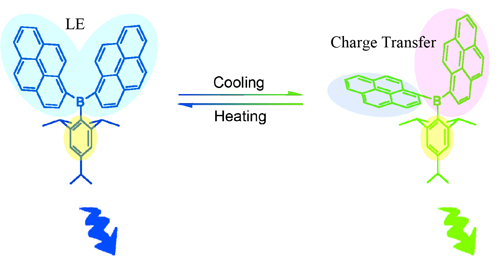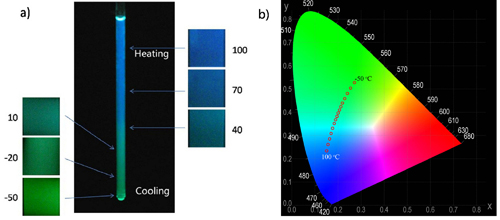Chemical sensor and device based on fluorescent materials have received more considerable attention in material science. Chemical fluorescent sensors have been developedin molecular and ionic recognition because of their fast response, high sensitivity and potential for real-time detection. Under the supports of the Chinese Ministry of Science and Technology, the National Natural Science Foundation of China and the Chinese Academy of Sciences, researchers in the Key Laboratory of Photochemistry of Chinese Academy of Sciences have studied on the synthesis of fluorescent materials and the design of new functional devices over the years. They have achieved efficient detection of positive metal ions and fluoride anion with high sensitivity and selectivity by using a series of fluorescent molecules with special structures with the principles of fluorescent chemical sensing.(Inorg. Chem., 2006, 45 (8), 3140;J. Phys. Chem. A, 2007, 111 (46), 1793; J. Phys. Chem. B, 2007, 111 (21), 5861, J. Phys. Chem. C, 2009, 113 (9), 3862; J. Phys. Chem. A, 2009, 113 (20), 5888,Angew. Chem. Int. Ed. 2010, 49, 4915-4918). Recently, they prepared a new kind of triarylboron compound for detection of temperature over a wide temperature range with high sensitivity. The results have been published in Angewandte Chemie International Edition, 2011, 50, 8072 –8076.
Usually, it was difficult to fabricate fluorescent chemical sensor over a wide range of temperature by using temperature-dependent fluorescent materials, because of the significant decrease in fluorescence efficiency with increasing temperature. In this work, a triarylboron compound was designed and synthesized to be used as a fluorescent component for thermometer detection. This compound showed unique property in solution that the molecules maintained high luminescence quantum efficiency at higher temperature with apparent molecular conformation changing. Meanwhile, it exhibited different fluorescence color from green at low temperature to blue at high temperature. By sealing the fluorescent solution in a thin porous film, a large area of temperature-sensitive material was fabricated to achieve high spatial resolution of tens of micrometers.

The mechanism of emission changes with temperature. (Image by YANG Guoqiang et al.)

a) Gradient fluorescence photographs at different temperatures (°C). b) The dependence of temperature in CIE chromaticity diagram of the fluorescent solution. (Image by YANG Guoqiang et al.)
